How do you boot a computer from punch cards when the computer has no operating system and no ROM? To make things worse, this computer requires special metadata called "word marks" that can't be represented on a card. In this blog post, I describe the interesting hardware and software techniques used in the vintage IBM 1401 computer to load software from a deck of punch cards. (Among other things, half of each card contains loader code that runs as each card is read.) I go through some IBM 1401 machine code in detail, which illustrates the strangeness of the 1401's architecture and instruction set compared to a modern machine.
The IBM 1401 was an early all-transistorized computer, so early that it didn't use silicon transistors but germanium transistors. It was announced in 1959, and went on to become the best-selling computer of the mid-1960s, with more than 10,000 systems in use. The 1401 leased for $2500 a month (about $20,000 in current dollars), a low price that opened up computing to many companies. Even a medium-sized business could use the 1401 for payroll, accounting, inventory, order processing, and invoicing.
To understand the 1401's architecture, it helps to understand how punch cards were used in that era. In 1928, IBM developed the 80-column punch card that became the standard for data processing for decades. A punch card held 80 characters, one per column, with the character represented by the holes punched in that column, as shown below. The 6-bit character set was limited to 64 different characters: upper case letters, numbers, and some special characters. Instead of binary, cards used a BCD-based encoding (which later was extended to create EBCDIC).1
Despite their limitations, punch cards were extensively used for data processing into the 1970s and beyond. A typical application used one card for each data record, so everything needed to fit into 80 columns2 which were divided up into fixed-length fields. Often, custom cards would be printed that showed the fields for an application, such as the card below designed for accounting.3 Each field has a fixed location. For instance, in the card below, the customer name is from columns 18 to 29 while the invoice amount is in columns 74 through 80.
The IBM 1401 has a peculiar architecture, optimized to support these punch-card applications. The idea is that fixed-length fields were be delimited in memory by word marks, a sort of metadata, and then instructions operated on these arbitrary-length fields. This let you move a 19-character name string with a single instruction. Or you could perform arithmetic on a 50-digit numeric field with a single instruction. Thus, word marks were convenient for fixed-field data, since you didn't need to loop over each character of the field.
To implement word marks, each memory location had 6 bits to hold a character as well as a separate bit to hold the word mark. (These were not bytes, as the IBM 1401 predated the popularity of byte-based computers.) It's important to note that the word marks were independent of the characters. Word marks were set or cleared using different instructions from the ones that acted on characters. Once word marks were configured, they remained unchanged as data records were read into memory.
Word marks were also critical for machine instructions since they indicated the length of the instruction. A machine instruction in the 1401 consisted of one to eight characters. The first character was the op code, potentially followed by addresses and/or a modifier. Each instruction needed to have a word mark set on the op code and a word mark on the next character after the instruction (i.e. the op code of the next instruction). Note that word marks create a problem. The machine instructions of a program are directly represented as characters on a punch card, but a punch card cannot hold the necessary word marks.
Thus, loading a program into the 1401 raised two problems. First was the standard computer bootstrap problem: if there's no program in the machine, what performs the load? But there was a second: word marks are a key component of 1401 machine code, but word marks cannot be represented on punch cards. In the next section, I'll explain in detail how the IBM 1401 solved these problems.
Loading a program
To load a program, a card deck, such as the short one below is placed into the card reader. Each card has the contents of the card printed at the top, with the holes punched in the columns below. The first two cards are bootstrap cards that initialize the computer's memory, clearing it out and setting necessary word marks. The bulk of the cards hold the machine code of the desired program on the left, and the machine code of the loader on the right. The last card runs the program.
At the far right of each card, columns 72-75 hold a sequence number (0001 through 0017). If you dropped a card deck, the cards could be put back into order by a card sorter, sorting on the sequence number.8
The load process was started by pressing the "Load" button on the card reader (the orange button near the center of the blue panel). This button causes several actions to take place.4 The first card was read, and the contents are placed in memory addresses 1 through 80. A word mark was set on address 1, and cleared from addresses 2 through 80. Finally, the instruction at address 1 was executed. Remember that these operations were implemented in hardware by boards with discrete transistors; there's no microcode or operating system to help out with these tasks.5
Bootstrap card 1
The first card contains the machine code:
,008015,022026,030040/019,001L020100 ,047054,061068,072072⌑08108110220001
The first instruction ,008015 is "Set Word Mark", a critical part of the bootstrap sequence.
The comma is the op code and the address arguments are "008" and "015".
(Since the 1401 is a decimal computer, not binary, the characters "015" are the same as the address 15.)
This instruction sets word marks at the specified addresses, 8 and 15.
Remember that an instruction needs to have a word mark on the opcode and a second word mark on the character following the instruction. The "Load" button put a word mark at address 1, but what about the second word mark? It turns out that the hardware has an exception for the "Set Word Mark" instruction 6 allowing it to execute without the second word mark. (This exception is crucial, since otherwise the first instruction can't execute. Was this carefully planned or a hack to make things work? I don't know.)
The word marks that were set by the first instruction let the next two instructions run. They are also "Set Word Mark" instruction, putting word marks at addresses 22, 26, 30, and 40. Note that each "Set Word Mark" instruction sets two word marks but only "uses up" one, so the code is making progress, preparing word marks for future instructions.
Now we come to /019; with the slash opcode indicating the somewhat curious "Clear Storage" instruction.
This instruction starts clearing storage at the specified address (19) and
proceeds downwards until the address is a multiple of 100.
Thus, in this case it will clear from address 19 down to address 0, erasing both characters and word marks.
(These locations contained the instructions we just executed.)
A location is erased by storing a blank; this may seem like a strange choice, but keep in mind that an empty punch card column is
read as a blank.
The next Set Word Mark instruction, ,001 puts a word mark back at location 1.
At this point, the contents of memory are as shown below. Word marks are indicated by underlined characters, which is how the IBM documentation indicated word marks.
40/019,001L020100 ,047054,061068,072072⌑08108110220001
The next instruction is L020100 "Load Characters to a Word Mark".
This instruction copies the character at address 20 (i.e. "4") to address 100.
The instruction then continues copying downwards (copying the blanks) until it hits a word mark (which is at address 1).
To summarize, addresses 20 through 1 are copied to addresses 100 through 81. Locations 81 through 99 received blanks, while address 100 received a "4".
This may seem pointless, but the "4" will turn out to be an important indicator shortly.
This instruction also illustrates how word marks allow a long field to be copied with a single instruction.
The next three instructions set word marks at addresses 47, 54, 61, 68, and 72.
(The boot code needs to go to a lot of effort to ensure that
word marks are set up for future instructions.)
The next instruction ⌑081081 has IBM's unusual "lozenge" character as the opcode. This instruction clears the word mark at address 81 (which had been copied from address 1).
The final instruction on the card, 1022, reads the next card (opcode 1 is "Read") and then jumps to address 22.
A lot has taken place to execute one card, but the next card has some remarkably tricky code.
Bootstrap card 2
After reading the second bootstrap card, memory locations 1 through 80 hold the data:
,008047/047046 /000H025B022100 4/061046,054061,068072,00104010400002
Execution of this card starts at address 22 with the Clear Storage instruction /000.
Remember how the Clear Storage instruction proceeds downwards until the address is a multiple of 100?
In this case, it will clear address 0 and then immediately stop on address 0 (a multiple of 100).
However, a register called the B register will hold the next address (counting downwards), which will wrap from 0 to the top address in memory.
For simplicity, I'll assume the code is running on a 1401 model with 1,000 characters of memory
so the B register will hold the address 999.7
The next instruction H025 is a tricky bit of self-modifying code. It stores the contents of the B address register into locations 23-25,
changing the "Clear Storage" instruction that we just executed to /999.
Next, the B022100 4 instruction will branch to address 22 if address 100 holds a "4" (which is true because the first card put a "4" there.)
Back at address 22, the Clear Storage instruction was modified to be /999, so it will now clear addresses 999-900.
It is followed by H025, which, as before will store the B register into the Clear Storage instruction. This time it will modify the Clear Storage to start at 899.
Finally, the conditional branch loops back to address 22 as before.
The result is that this loop clears memory 100 characters at a time, using self-modifying code to update the position. This loop continues until addresses 100-199 are cleared. At this point, the branch instruction will fail because address 100 holds a blank and not a "4". At this point, the loop has cleared all of storage from 100 to the end of memory, erasing characters as well as any word marks.
The next instruction is Clear Storage /061046 which clears storage from address 46 down to 0 and then branches to 61.
At address 61, ,001040 sets word marks at addresses 1 and 40.
Finally, 1040 reads the next card and starts execution at address 40.
As with the first card, columns 1 through 80 of the card are read into memory addresses 1 through 80.
The program cards
The next phase consists of reading the desired program into memory. A typical card is:
3332200999&2200&0000000100000 L029368,343346,351356,36136410400004
The left part of the card (columns 1-29) contains machine code for the program that we want to run. The right part (columns 41-71) contains the loader code that will execute card-by-card, loading that code into the right part of memory and setting word marks.
The first loader instruction L029368 copies the program code from the card reader buffer into the desired memory locations. Specifically, it will copy starting from address 29 down to the word mark at address 1. These characters will be copied into addresses 368 down to 340.
The next instructions set the word marks in this code, at addresses 343, 346, 351, 356, 361, and 364.
This answers the question of how the program in memory gets word marks even though punch cards can't explicitly store word marks.
Finally, 1040 reads the next card and starts executing it at address 40.
The following cards have the same structure: the program on the left and the loader code on the right. Interestingly, the number of characters of program code is variable because the loader code can set at most 6 word marks per card. In the worst case, all the characters need word marks so only 6 characters can be provided by the card. In the best case, 40 characters can fit on the left side of the card.
The run card
The last card has the Clear Storage instruction /333080. This clears memory from address 80 downwards to 0, wiping out the
card buffer and the loader code so the program will start with a clean slate. The Clear Storage instruction then jumps to address 333, starting the execution of the program.
After all this work, the computer finally runs the program we wanted to run.
While the loading process seems very long when written out, the card reader is fast for an electromechanical device, with over 13 cards
per second zipping through it.
The program I used in the example is a Mandelbrot fractal generator that I wrote. The photo below shows the results of the program, which took 12 minutes to execute. I discuss the program in detail in this post.
The bootstrap code I described above is just one of the possible bootstrap sequences. Programmers could write their own bootstrap code, trying to make it as short as possible. I described a longer three-card sequence here. The IBM 1401 could also boot from a magnetic tape using a similar process; pressing the "Tape Load" button on the console loaded a record from tape, just like booting from a card.
The origins of "bootstrapping"
The term "bootstrap" has an interesting history. It starts with physical boots, which often had boot straps on the top, physical straps to help pull the boots on (as shown below). In the 1800s, the saying "No man can lift himself by his own boot straps" was used as a metaphor for the impossibility of improvement solely through one's own effort. (Pulling on the straps on your boots superficially seems like it should lift you off the ground, but is of course physically impossible.)
By the mid-1940s, "bootstrap" was used in electronics to describe a circuit that started itself up through positive feedback, metaphorically pulling itself up by its boot straps. (See usages from 1943, 1944, and 1946). By 1952, analog computers used circuits called "bootstrap integrators".
When a digital computer loaded its program through its own efforts, this took on the name "bootstrap", dating back to the 1950s. (Using a program to load a program seems as paradoxical as lifting yourself up by your bootstraps, but fortunately it works.) A 1954 glossary defined "bootstrap" as "The coded instructions at the beginning of an input tape, together with one or two instructions inserted by switches or buttons into the computer, used to put a routine into the computer." A 1955 computer survey published by the Department of Commerce had a similar definition.
Conclusion
Bootstrapping the IBM 1401 was complicated, and the process has become even more complex in later computers. In the 1960s, computers such as the IBM System/360 had bootstrap microcode stored in read-only storage. This code could load a chain of bootstrap programs, first a 64-byte bootstrap card, which would then load a 4-kilobyte bootstrap program, which could then load the disk operating system. Some early minicomputers and microcomputers lacked ROM and took a step backward, requiring the user to tediously toggle in boot code through switches on the front panel.
Modern computers go through a much more complex bootstrap process. The initial boot code for an x86 system is stored in ROM, and booting happens through the BIOS in older computers or UEFI in more modern systems. The system starts in a primitive state without caches or virtual memory, running a single core in "8086 real mode". The boot code sets up the system and loads a bootloader program, which may then load another bootloader, which loads the kernel, which starts up the computer's various processes. Details are in this presentation.
Studying the 1401's machine code shows many of its unusual characteristics compared to modern computers and the strangeness of its instruction set. Needing to deal with word marks is the most obvious difference, with special instructions to set and erase them. From a modern perspective, it's unusual to see a computer that doesn't use bytes, although that was common back then. The use of decimal arithmetic and decimal addressing also seems strange from the modern perspective. Another curiosity is self-modifying code. Although self-modifying code is discouraged nowadays, it was common on the 1401 (as with other computers of that era).
I announce my latest blog posts on Twitter, so follow me @kenshirriff. I also have an RSS feed.
Notes and references
-
While punch cards almost always held character data, an optional feature called "column binary" allowed binary data to be punched onto cards, 12 bits in each column. IBM charged $101 a month (in 1960s dollars) for the column binary feature. ↩
-
The need to fit all the data into 80 columns was one of the factors that led to the Y2K problem. If you used four columns on a card to hold the year instead of two, you'd need to give up two precious columns somewhere else. ↩
-
The punch card below is an example of a card custom-printed for a customer application. This card was used for payroll at the Phoenix Steel Corporation.
A punch card designed for a steel mill. -
The operation of the load key is specified in the 1401 reference manual (p118): "This key is used to start loading instruction cards. Pressing the load key operates the read feed until a card has passed the read station. The I -address register is set to 001, and a word mark is set in address 001. All other word marks in addresses 002 through 080 are removed." The instruction in the first columns is executed, and then continued operation is controlled by the first instruction. ↩
-
How does the first word mark get set when you load the first card? I looked at the documentation of the circuitry and found the relevant flip-flop (below). It is set by the load button, sets the first word mark (WM), and then is cleared.
The flip-flop to set word marks. From the 1401 logic diagrams, figure 81.The photo below shows the card that implements this flip-flop. With the 1401, you can actually see the physical transistors that implement each function.
A flip-flop card, type "CW". -
Instructions need to be indicated with word marks with a few specific exceptions. As documented in the 1401 reference manual (p15) "The 4-character unconditional branch instruction, the 7-character set word mark, and clear storage and branch instructions are the only instructions that can be followed by a blank without a word mark. All other instructions must be followed by a word mark." ↩
-
The 1401 computer that I used has 16,000 characters of memory (not 16,384 because it's a decimal machine!) so after the Clear Storage instruction, the B register will hold 15,999, pointing to the top of memory. You might wonder how the address 15,999 is represented in three decimal characters. The trick is that a special address code uses the top two bits of the characters to hold the kilobyte part of the address. The resulting address is 999 with the top two bits of the hundreds and units characters set. The result is the three-character alphanumeric address I9I represents the address 15,999. ↩
-
If you had the misfortune to drop your cards, a card sorter could put them back in order using the sequence numbers. A card sorter rapidly sorted cards into slots based on the digit punched in one column. By running the cards through several times, you could sort on the complete sequence number. I discuss card sorters in great detail here. (A low-tech way to keep cards in order was to draw a diagonal line across the top of the cards; it helped when putting cards back in order manually.)
An IBM Type 83 card sorter. Cards enter the machine on the right, whiz along the top of the machine, and fall into the appropriate hopper underneath.The use of sequence numbers in columns 73-80 goes back to the Fortran language. Fortran was developed for the IBM 704 vacuum tube computer. The 704 was a 36-bit machine. The punch-card reading process used two 36-bit words, so only 72 columns could be read. (These could be any 72 columns of the card, selected by a wiring panel, but typically columns 1-72 were used.) The result was that columns 1-72 were used for code (a restriction still often used), while columns 73-80 were free for sequence numbers. ↩
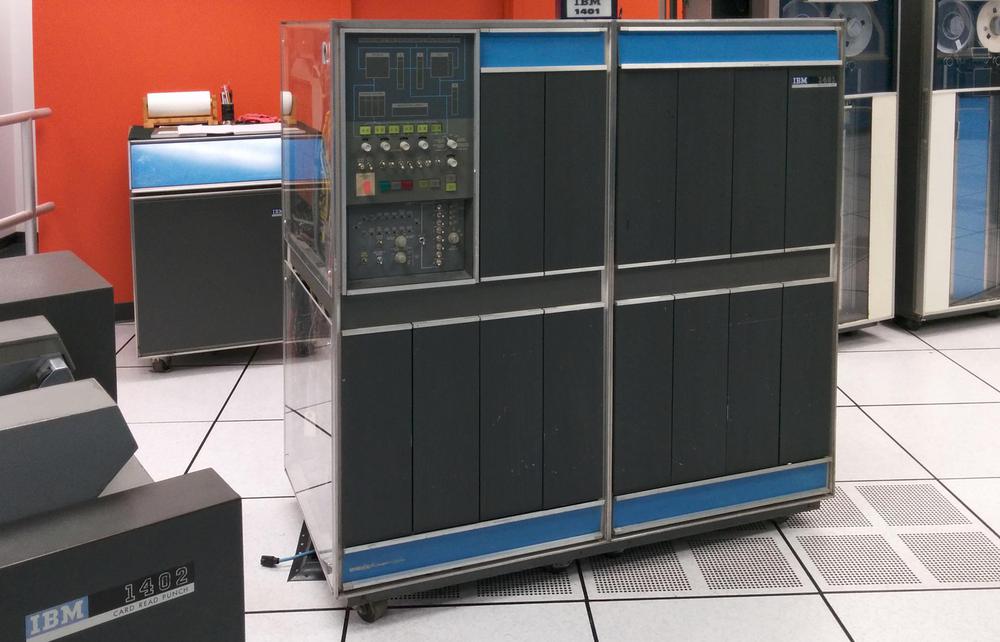
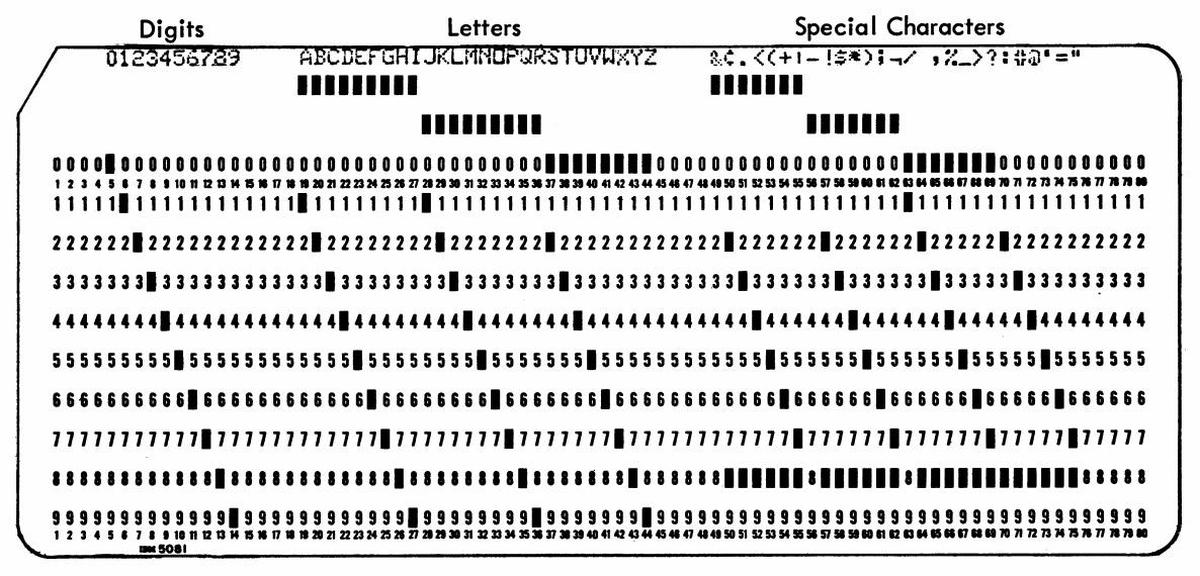
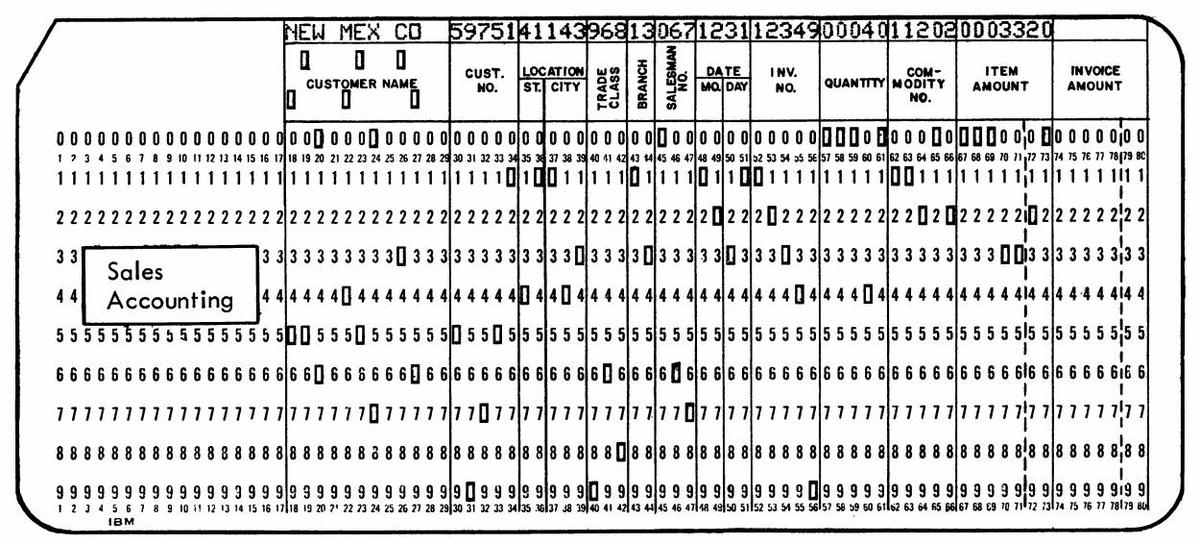
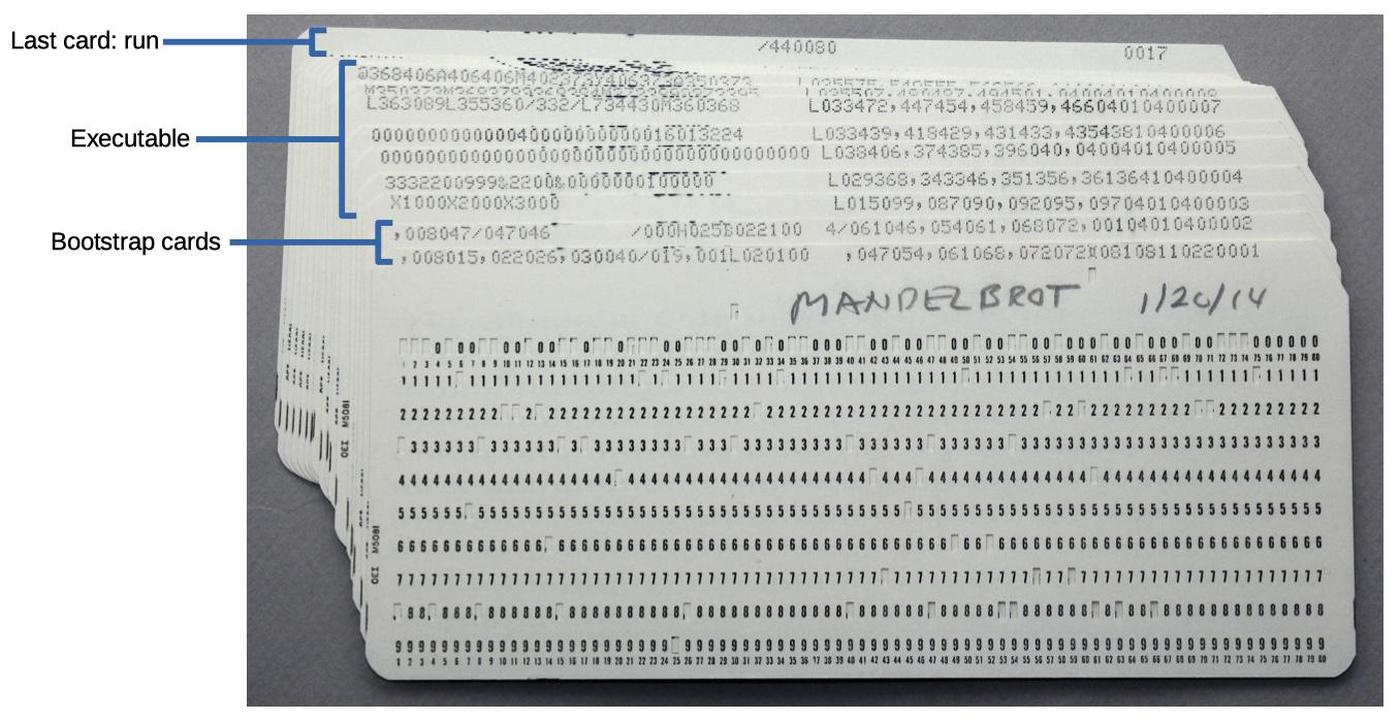
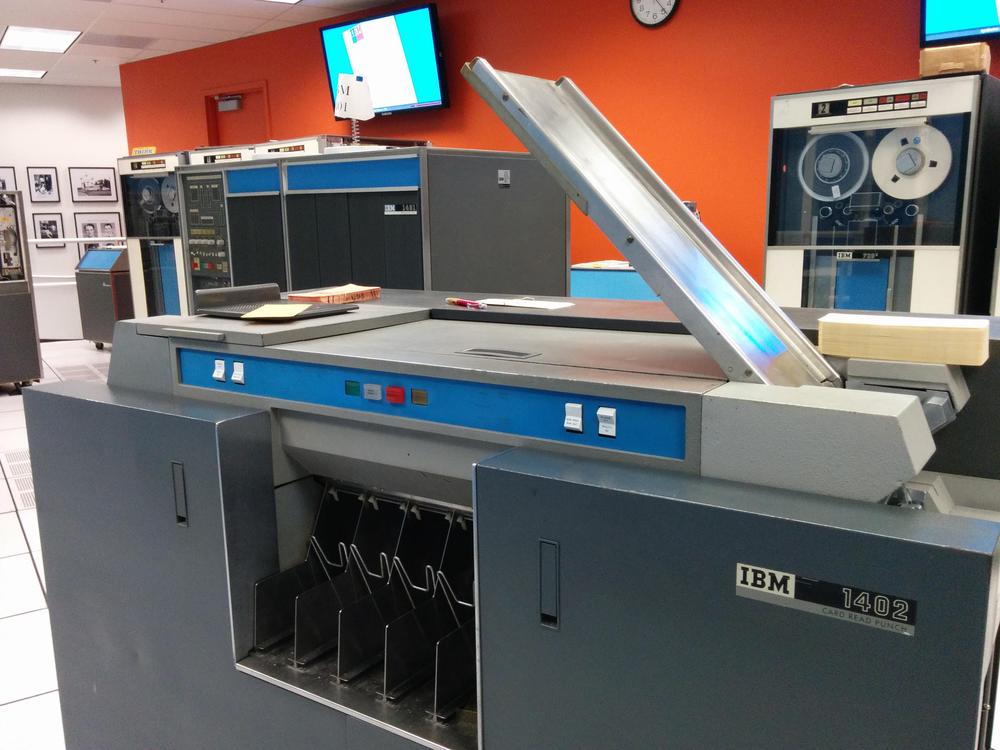
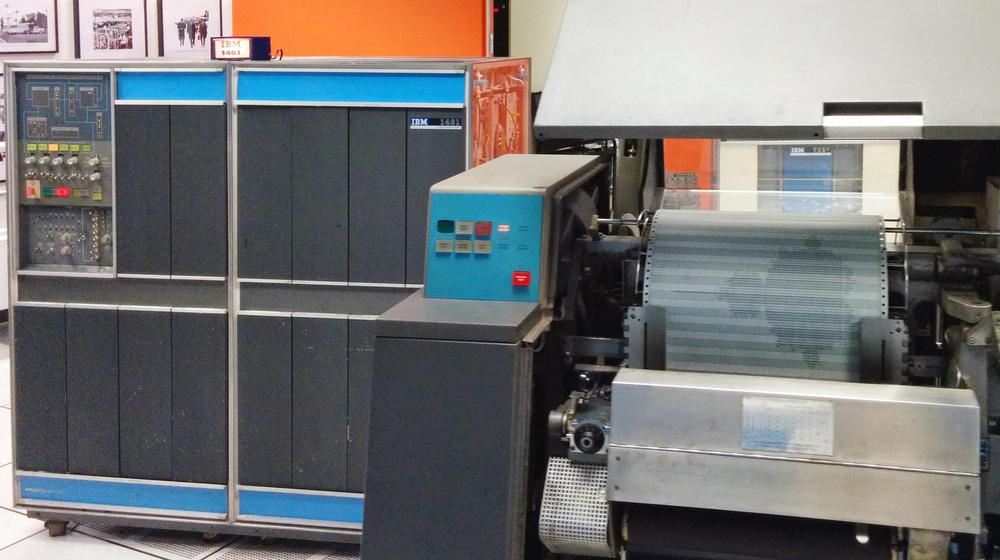
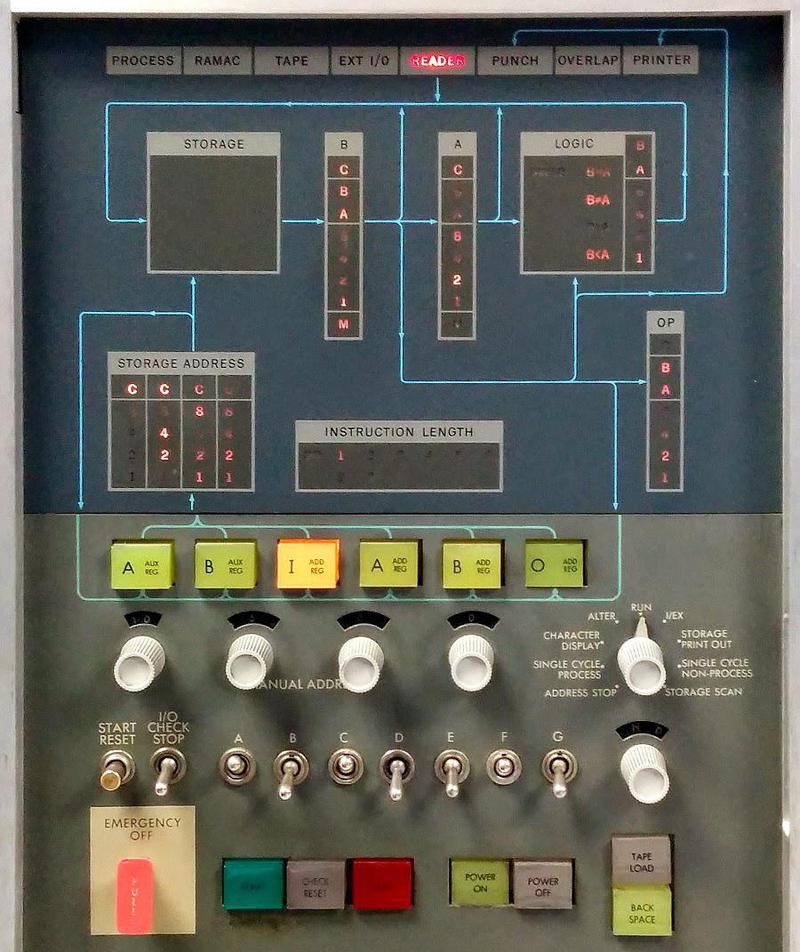
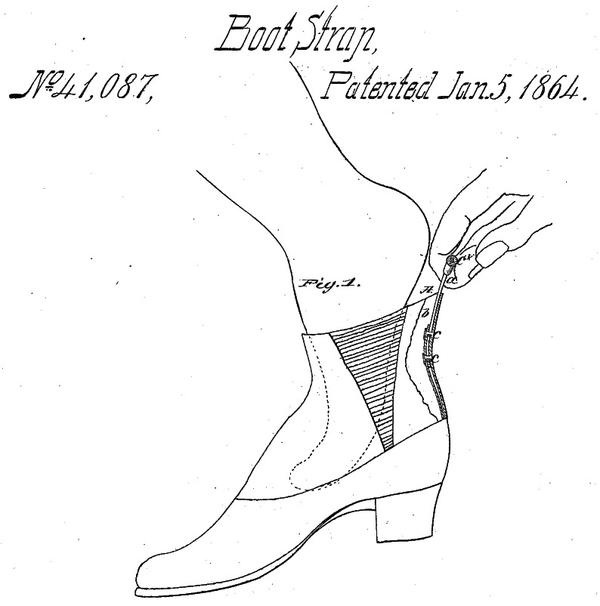
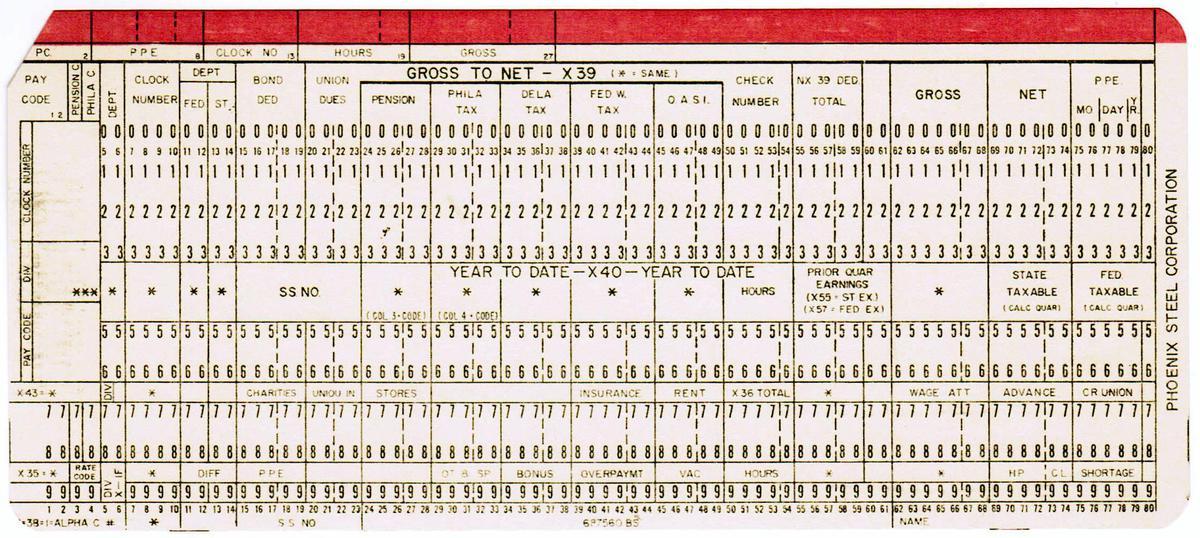
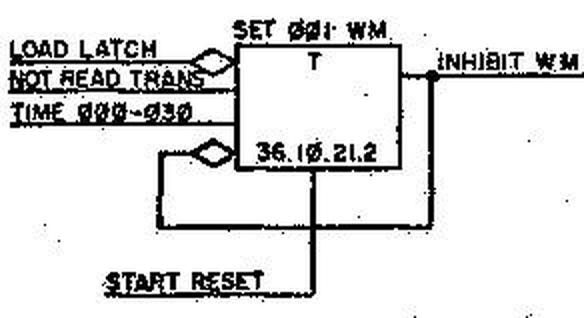
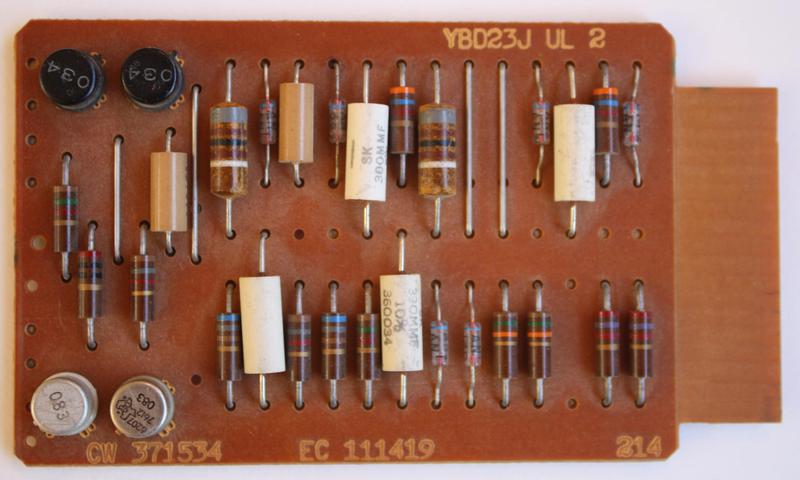
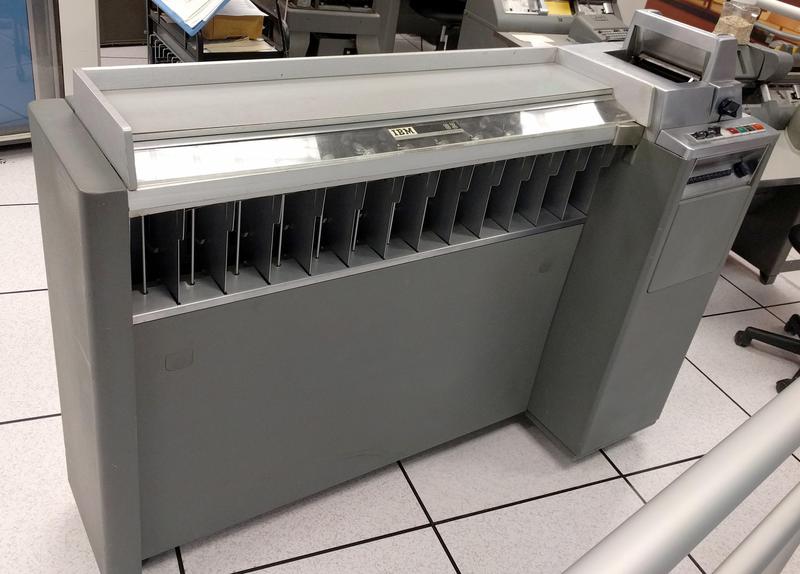
20 comments:
Punching sequence numbers in each card was a lot of trouble. So lots of times source program decks didn't have sequence numbers. Thus the diagonal line hack mentioned.
Fascinating stuff, as always!
Since each program card includes the address into which its part of the binary should be loaded (as well as which marks to set) it seems to me that if you drop your deck and load the cards in random order everything would still work. As long as the first two and the last card are the right ones, of course.
First machine I worked on (in 1965) was an IBM1401G with 4K memory.
First program written in anger was part of a payroll system for Rank-Xerox at Denham, NW of London. No tape drives, just punched cards in and out and a printer. That had 64K memory IIRC.
You may like 1401s I Have Known https://multicians.org/thvv/1401s.html
which has a one-card HELLO WORLD program and a little history.
When I learned about boot-strapping (as a computer term), I soon learned it came from a physical boot and not the computer's boot process. Then I was even more confused.
I am confused why there is a limit of 6 word marks per program card. There looks like there's more space that's unused. Like the habbit of always putting the loader code at column 40. That seems arbitrary. Couldn't the cards be packed by adding code until you ran out of columns of data+loader and having the previous card jump to the beginning of the loader (where ever it might be on the following card)? You'd need a two card buffer as you couldn't emit a card until you knew what you were going to put on the next one.
Am I missing something important?
Jecel: yes, this loader should handle the cards in random order, but I haven't tried that out. Willmore: there are optimizations that could be done. However, the assembler ran in 2K of memory, so there wasn't space for a two-card buffer or clever optimizations.
I take it that the $101 amount IBM charged for the Binary column option, was not interpreted as $5 although I assume they chose 101 to represent a binary value?
The 1401 and 1130 were the first computers I worked on.
On the 4K (decimal) 1401, we mostly used SPS for administrative-type programming. That was around 1969.
I do remember getting frustrated with the assembly process for trivial programs, so I wrote a one-card boot loader that accepted any number of cards containing machine instructions separated by a never-used keypunch character (I think it was yen, ¥); the loader set work marks based on that symbol. A double ¥¥ started the program.
Tricky to get it to fit on a single card, but it saved me much time afterwards… thanks for bringing back these memories!
Thank you for your reply, Ken. The way I read it in your article implied that "of course there's only this way to do it" so I thought I must have missed something.
I fully understand the limitations of the hardware at the time. I had in mind using modern hardware to make more optimal cards for the machine.
At the University I went to, they charged for everything on their 360, including the number of cards read. This led programmers to store their data in binary, which let them stuff much more data on each card and cut down on their card count. However this resulted in "lace cards" which had so many holes in them that they lost their rigidity and often got jammed in the card reader. The operators hated those since they had to stop the reader, clear the jam, then put the offending card back in and single-step it before they could get back to reading their comic book.
Relating to the comment " Some early minicomputers and microcomputers lacked ROM and took a step backward, requiring the user to tediously toggle in boot code through switches on the front panel. "
The HP 2100 systems had a special area of memory that was reserved for the boot code.
The user had to input the code for the selected boot device by the front panel switches.
Ounce entered, that code is protested and as with core memory, it remains in the machine.
What @Stan said. One of the [few] joys of core-memory era minicomputers was the ability to power it on, toggle in the OS resume address, and (if it'd been turned off properly) you just hit Load Address, Start and resume where you left off.
After 40 years of computing with binary representations, it takes a lot of effort for me to grok how this “decimal” computer thinks. I love it.
Very nice article. Small correction about modern computers. “System starts in a primitive state without caches or virtual memory”… that was true some time ago, but in modern world it's the exact opposite: system starts with cache as the only memory available! It then proceeds to execute “the Intel reference code binary required to get memory up and running”… (see here: https://lwn.net/Articles/537791/ )
I was surprised to find out that it's done like that, but after some thinking realized that it made perfect sense: cache is pretty large in modern CPU, it's always there, it's always available, so why trying to teach hardware to initialize DRAM (which is not exactly trivial nowadays) and make it running in hardware when software can easily do that?
The flipside of that is obvious: you couldn't run anything on a modern system without executing some proprietary Intel code which does god-know-what.
In the 1970s, if you made a wrong perforation in one card, you would lose a day, of the deadline for submitting the work! By default, we have become an extremely detail-conscious generation! I worked on an English computer I.C.L. in Bucharest.
If you want to program and run the IBM-1401, search for "1401 simulator" and you will soon learn about "ROPE". This package makes it easy to write programs in 1401 Auto-coder and assemble and run them.
Caution - you may get hooked all over again. Some of the links are captivating!
No, Jecel and Ken. If the cards were dropped and picked up out of order the program would not run since execution takes place as each card is loaded, not after all cards (instructions) are loaded. The "1040" instruction in each card tells the system to Read the next card and branch to position 040 to execute the next sequence of loading instructions which must be done in card sequence order.
Sorry to necro these comments. I just read this fascinating article and felt the need to offer some clarification to the other people reading here.
Flyzone: the cards can totally be loaded in any order. Each card copies the code to a specific memory address, so the card that contains the contents of addresses 340-368 contains an instruction that loads to that specific address an no other. If you ran the cards out of order, then memory would simply be filled in random order, but always with the correct data. The only requirement is that the two bootstrap cards must be the first two cards in order, and the run card must be last.
willmore: you *are* missing one important thing - the word marks. The first card has 11 instructions on it and 7 of them are for setting word marks. It takes a lot of gymnastics to get the word marks set on all of the right characters in order to allow the instructions to actually be executable. The loading cards only work because they have the same instructions at the same positions so they inherit the same word marks that were set when the bootstrap cards loaded and ran. The first 40 characters only have a word mark in position 1 to delimit the characters to be copied into main memory. The other 40 characters have word marks to identify (1) the copy instruction that loads the code into memory, (2) the three word mark instructions to set the word marks on that code, and (3) the load next card instruction. Changing the set of instructions on the next card would almost certainly need at least one extra card just to change the position of the word marks, negating any benefit you might gain from squeezing a couple of extra characters of code onto that card.
Post a Comment